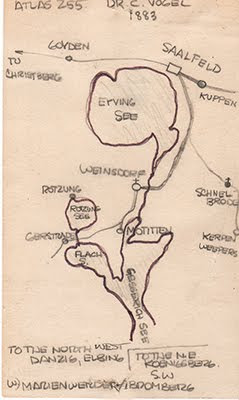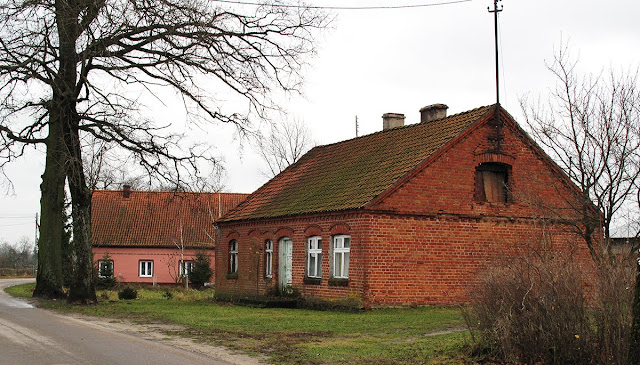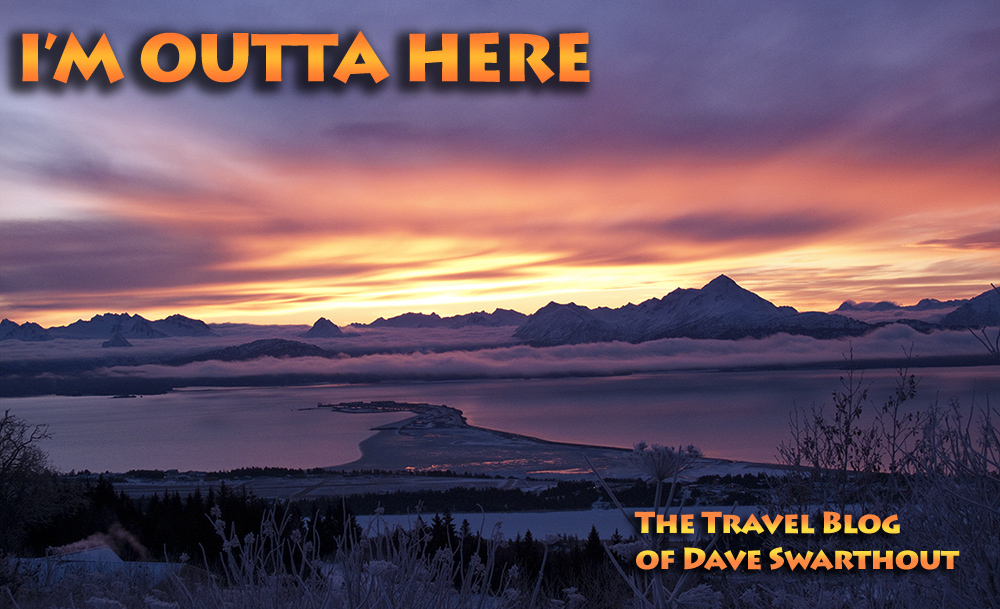I finally made it to my Grandmother's hometown yesterday. I rented a car from Avis in Gdansk
 My first stop was Zalewo, the bigger town my grandmother walked to for things like coffee and sugar. In 1907 she knew it as Saalfeld. Saalfeld and Weinsdorf were located in
My first stop was Zalewo, the bigger town my grandmother walked to for things like coffee and sugar. In 1907 she knew it as Saalfeld. Saalfeld and Weinsdorf were located in Note, January 2015: In my original post, I had included a portion of a map of Prussia I had found online. The waterway my grandmother told me about was just barely visible on that one. I just located a much better map on the wonderful David Rumsey Historical Map Collection site. The level of detail in this image is fantastic. The main map is quite large and is a composite of 674 sheets scanned at 800 dpi. (More details are at the end of this post.)
 |
| Map of Germany, published by Reichsamt fur Landesaufnahme, 1893 courtesy of David Rumsey |
A complete album of photos resides on the Picasaweb server at Dobrzyki Scenes. My Couchsurfing host, a lovely lady named Ewa, with much patience told me how to pronounce that name but I failed completely. The best I can come up with is DUB-zhuk-ee for a phonetic approximation. But the zhuk part is spoken with a slight roll of the tongue. Tricky, very tricky.
The shot above is from Google Earth. My GPS track and dates is shown in red. I added the historical town names when I edited the screenshot. The two photos below are aerial photos of the countryside that surrounds Dobrzyki. I "borrowed" these from the Google Earth community.
After Zalewo I turned south on the only road that goes to Dobrzyki. The countryside around here reminded me of certain parts of New York State; gently rolling hills, dairy farms, and small towns close together. Coincidentally, the area grandma lived for most of her life after immigrating was very similar to this. The roads all around are lined with big oak trees, old trees, trees that I'm certain were here when my grandparents walked, drove a wagon(?), to Saalfeld on shopping days over this very road. The mental image I had of them walking alongside these same fields and wooded areas, seeing the same farmhouses I was now seeing, catching glimpses of the church steeple in Saalfeld through breaks in the forest, was very powerful.
Suddenly I came round a bend in the road and saw some houses up ahead and noted a little bridge with a road sign on it; DOBRZYKI. At the same time I spotted a cemetery on the right hand side of the road. I immediately pulled over to look at the names on the gravestones hoping to find a Schwede or a Gunther. No luck, it was a Polish cemetery, beautifully decorated with flowers and oil lanterns for almost every grave. At night you can easily see the Polish cemeteries on the surrounding hillsides because they're all lit up. Apparently, relatives of the deceased go there every night to light the oil lamps. (I later learned that November is a special month for honoring the dead.) I looked all around. I saw no German names nor did I see any older headstones of any sort. Before going back to the car I had the realization that this little bridge just ahead must cross grandmother's "river." Not wanting to rush into the town and wanting to savor my discovery, I began to look more closely at the little waterway below me.
 |
| Grandma's "river" looking north |
Note- May 20, 2012: Google Earth has new imagery of this area so I updated the blog with the image below. The center of this map is at approximately N53.811563 and E19.585230 if you want to explore the neighborhood in Google Earth.
 |
| The town of Dobrzyki was known as Weinsdorf in 1907 |
Further along the path I saw buried in vegetation and fallen leaves what must have been stone bases to put over graves and some low upright posts made of stone, delineators of this old cemetery. I surmise that headstones attached to the bases in some way. By dumb luck I had stumbled across an old German cemetery! I looked all over the area as best I could and at first could find no other headstones. In reviewing my photos weeks later I saw that there was actually a German headstone in those ruins that I had missed before. Below is a photo of that headstone. (Click on the photo for an enlarged version.)
 |
| Single German headstone in the abandoned German cemetery |
Now I'm only guessing but I'd be willing to bet that when
I had my lunch on what might have been the old towpath alongside the canal. While I ate I listened to the sounds of dogs barking and roosters crowing in the town just a few yards distant— probably the same sounds Grandma used to hear when she was fetching water from near where I was sitting. I reckon nothing much has changed in the hundred years since she left. After my lunch, I headed into town.
Dobrzyki is a tiny little town. One main street, the highway I drove coming from Zalewo, a couple of unpaved roads going to some smaller towns on nearby Lake Jeziorak (Geserich See in grandmother's day), no grocery store, no gas station, just a few old homes and farmhouses, a few restored homes sprinkled into the mix, a newer school building, and that's about it. I imagine the residents still drive to Zalewo to do their shopping. After all I had done to get here, I must admit it was a bit of a letdown. The gray skies and November chill didn't help any. But I walked back and forth on the street shooting photos of practically every house along the way. Again, those photos, which will be of interest mostly to family members, are in a Picasaweb album called Dobryzki Scenes. Here's my favorite house photo from that album. One wonders if my Grandmother knew this house, perhaps even lived in it.

Next I drove to the tiny town of Matyty (Motitten on my map) on Lake Jeziorak and almost got stuck in mud when I attempted to reach another little town, Kiemiany. So I turned the car around and headed to the next town on my list, Boreczno or Schnellwalde, which is where my family members were baptized. At the time it was an Evangelical Lutheran church but I would think it's Roman Catholic now. This town is even smaller than Dobrzyki. The church, a small school, and a few houses comprise the town proper. A plaque on the parsonage labeled it as a historical site and that the church was built in 1730. I peeked inside but I couldn't get in as there was a wrought iron gate barring entrance. At this point, there was a chill wind blowing and although I had wanted to do more exploring, my back was killing me so I headed back to Elblag. Unfortunately, when I tweak my back and it "goes out" like it did earlier it's extremely painful and can put me down for days or even weeks. The absolute last thing I want to be doing when that happens is driving a car. Reluctantly I turned around, took one last look at Weinsdorf, and then headed back to Elblag with my curiosity reasonably satisfied and my back screaming, lay down, lay down!
I'm writing this sitting in a too small chair and will probably pay for it later. Tomorrow I return to Berlin and am looking forward to a chamber music concert on Saturday. Luckily I have some powerful pain pills with me as well as a muscle relaxant from my last back problem this spring. I'm betting, perhaps hoping is a better term, that I can nip this in the bud. Sans back injury I would have liked to ask around, see if anyone spoke English, ask about the history of the town. But, I was in acute pain. It was with great reluctance that I took leave of Dobrzyki after only a few hours.
This morning I drove back to Gdansk to return the car. It took about 15 minutes before I could walk fully upright. I want to tell you about the Avis agent, a very nice guy by the name of Konrad, who was so very nice to me. He apologized after he calculated the total I was supposed to pay because it was so expensive. He tried different ways to figure my bill to lower the total. I had the car for less than two days and drove about 300 km. The bill came to 900 zlotys or about $360 USD, an astronomical amount, especially if you consider that the price I paid to fly from Anchorage to NYC was only $250! So Konrad typed and he tabbed and he made some sort of corrections that brought the bill down to 866 zlotys. He said, "That's not very much difference. Let's try this." So he typed and tabbed and typed again for a while. This time he came up with a figure of 700 zlotys. What a guy! Yet even after all he did, and if the 71 zlotys to fill the tank are included, this 2-day car rental came to approximately $312 USD. I'm damn glad I didn't ask up front how much money was involved because I wouldn't have done it, which is exactly why I didn't ask. It’s no mystery why most people in Poland don’t rent cars. Ouch!
Anyway, it’s more or less Mission Accomplished as I head back to Berlin for a few more days. After that it’s on to Amsterdam.
Friday, November 20
I’m riding the Berlin Express from Poznan, Poland, to the Berlin HBH. (HauptBahnHof=main station) Thanks to my GPS I found that this train was running at 100 mph, slowing down only when it passes stations at which it isn’t stopping, and then it only slows to 80-85 mph. We’re racing along. Going to Elblag I had a 4-leg trip, one of which was on a cramped and crowded bus, the others on slow commuter trains that made frequent stops. My return trip involves 3 separate trains but they are moving faster and making fewer stops, especially this last one. I’ll be glad to get back to Berlin I guess. I have those tickets to the chamber music concert for tomorrow night and seeing as this is the last leg of my return it looks like I’ll make it just fine.
A few more notes about Poland. Lots of homes burn coal. One sees piles of it in the towns and in people's yards. Although it’s warm today many chimneys are belching clouds of black smoke. Smells much like the coal we burn in Homer. (Observed as I write: a good looking young woman in the station at Tczew (pronounced t’chef ) who is wearing dark nylons with low-cut athletic sox like I wear for tennis. But unlike me she's wearing high heel shoes to complete her outfit.) Today has been sunny and the areas we’re moving through are nice looking farmland. The winter wheat is greening many of the plowed fields and in some areas the last of the feed corn is being harvested. It’s not all that different from what you might see in my home state of New York; the gently rolling hills and plowed fields interspersed with pastures and fields of corn looked mighty familiar. In fact, in an email exchange with my cousin Roger we discussed how Grandma must have thought the area where she spent a lot of time, the gentle hills south of Buffalo, looked much like the neighborhood in East Prussia she'd left behind.
In closing I must again mention my wonderful Elblag Couchsurfing hosts, Ewa and Daniel. They made my stay in Poland very enjoyable despite the fact that Ewa commutes to Gdansk every day, 1.5 hours each way by train or bus, to work for Lufthansa. She loves traveling and can get great reductions in airfare with this job. But the trade off is this very long commute. Despite her long day Ewa is very curious about Alaska and spent precious hours of her time at home chatting with me. Both of them were gracious, warm, and very generous with their time and small apartment space. Thank you, thank you, Ewa.
|
Notes on the David Rumsey map:
Published by Reichsamt fur Landesaufnahme, 1893
Publisher's Note :
In an agreement dated March 4, 1878, the states of Prussia, Saxony, Bavaria, and Wurttemberg (the areas of modern day Germany, Luxembourg, Poland, and Kaliningrad, and part of Lithuania) agreed to map their areas on a 1:100,000 scale in a common topographic grid survey consisting of 674 sheets. Each sheet covers about 30 minutes in longitude and 15 minutes in latitude. One centimeter on a map is equivalent to1 kilometer on the ground. Average sheet size is about 35 cm x 28 cm. Each sheet covers about 1000 square kilometers and was engraved on copper.
The map is a composite of Sheets 1 to 674. Date estimated based on the apparent library acquisition date usually stamped on the back of the map sheet. This map series is remarkable for the level of fine detail. As a consequence, it was scanned at 800 PPI providing four times the resolution of the typical detailed map scan of 400 PPI. At least ten separate symbols for special buildings were utilized, a method enhanced by placing an abbreviation next to the symbol. Structures with special symbols include: churches, chapels, monuments, windmills, water mills, stamp mills, forester's lodges, watchtowers, ruins, forts, quarries, clay pits, lime kilns, and coke-ovens. Factories, brick works, powder magazines electric power plants, and many other important buildings are differentiated by means of abbreviation. Houses appear as black blocks, either rectangular or shaped like the ground plan of the building. Many other features are differentiated, for example there are four different qualities of roads plus bridle paths and footpaths. Vegetation is minutely classified including separate symbols for broadleaf trees, evergreens, underbrush, heather, dry meadows, wet meadows, swamps, orchards, gardens, vineyards, and parks. Relief is shown by hachures. Spot elevations are given in meters above sea level.
In an agreement dated March 4, 1878, the states of Prussia, Saxony, Bavaria, and Wurttemberg (the areas of modern day Germany, Luxembourg, Poland, and Kaliningrad, and part of Lithuania) agreed to map their areas on a 1:100,000 scale in a common topographic grid survey consisting of 674 sheets. Each sheet covers about 30 minutes in longitude and 15 minutes in latitude. One centimeter on a map is equivalent to1 kilometer on the ground. Average sheet size is about 35 cm x 28 cm. Each sheet covers about 1000 square kilometers and was engraved on copper.



.jpg)





Hi Dave - if you ever need a job, you can become a journalist or just an author. You are a wonderful writer. Your descriptions are fabulous. You make the normal very real. Your blog is fantastic and I so enjoying wandering about in Europe while reading it.
ReplyDeleteSure sounds as if you are doing very well. I like that you are savoring the simple treasures of the various countries. Sounds as if you are really enjoying your couchsurfing hosts. Yours photos are incredible. Your museum pics really show the detail. I like the scenic landscapes. Good job.
Glad that you got to catch some tennis in Paris. I watched a lot of that tournament from my room in Coalcoman, Mexico. I hope to catch some of the ATP finals that is being held in London on my TV. 8 great players are set to battle it out.
Keep enjoying your trip!!!
Kathy Hill
katmhill@yahoo.com
Well thank you Kathy for the nice comments. If you read the earlier posts you know I was badgered into doing this blog by my good friend and partner Doug. I resisted as long as I could, knowing that it would require a lot of work once I committed to it, but eventually I gave in because I like to write. And I have been enjoying it since. Stay tuned....
ReplyDeleteHey Dave,
ReplyDeleteMy Mother comes from Motitten, she left when the Russians moved through during WWII. I wanted to go visit but I was unable to get approval to go into that area of the world due to my previous occupation with the Air Force. Since relation between the U.S. and Russia are not so confrontational anymore, maybe I can try again. Were their any places to stay in the Mottiten area? How about the people, were they friendly?
Looking forward to your response - A Fellow Prussian American!!
jwyogi@charter.net
I wrote a 130 side long book of the hostory of Weinsdorf and my family. They lived there from 1305-1945. My grandmother talks every time alot of her old home ❤❤❤
ReplyDeletePlease contact me for the book. You can get for free.
Watzmann1986@web.de